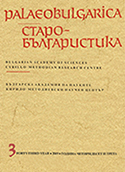Възрожденската кирило-методиевска традиция в иконографията на един непубликуван стенопис от с. Баня, Панагюрско
The Renascence Cyrillo-Methodian Tradition in the Iconography of an Unpublished Fresco from the Village of Banya, Panagyurishte District
Author(s): Totka GrigorovaSubject(s): Language studies, Language and Literature Studies, Fine Arts / Performing Arts, Visual Arts
Published by: Кирило-Методиевски научен център при Българска академия на науките
Keywords: Bulgarian Renaissance; church “St. Nicholas” in the village of Banya, Panagyurishte district; icons and frescoes depicting Sts. Cyril and Methodius; Bulgarski bukvar; painter Ivan Stoyanov Zografski
Summary/Abstract: The mural depicting Sts. Cyril and Methodius at the church „St. Nicholas“ in the village of Banya is a typical example of the role of the Bulgarian icon-painters and the Cyrillo-Methodian theme in the reawakening of the Bulgarian people during the Bulgarian Renaissance. The current church building was built in the middle of the 19th century, the icons found in the church and the only mural scene there were created somewhere between the middle and the second half of the 19th century. The comparative analysis of the mural and the images in closest proximity to it shows that the icon-painter built the iconographic scheme on the basis of the famous image from the “Bulgarski bukvar” [Bulgarian primer], which he obviously knew in great detail and followed very closely. The icons and frescoes depicting Sts. Cyril and Methodius are divided into two main groups according to their compositional features and peculiarities. In the first group Cyril and Methodius are depicted separately whereas in the second one they are represented together. The frescoes in the village of Banya are connected to one of the characteristic images in the Cyrillo-Methodian pictorial tradition – namely, the one in which Cyril and Methodius are depicted in monastic attire. This pictorial scheme emerged during the Bulgarian Renaissance, but remained less widespread. In view of the fact that the frescoes in question were definitely created in 1861, and that the name compositional change started to occur in the middle of the nineteenth century, it can be assumed that the fresco is probably among the first images in which this invention emerged. On the basis of a thorough analysis of the details and inscriptions providing information about the exact date of the frescoes’ creation, the occasion for their creation and the donors that contributed to their realization, as well as the study of the icon-painters who worked in the church, it can be concluded that the fresco was probably one of the early works of the painter Ivan Stoyanov Zografski (Papazov), who at that time lived and worked in the village of Banya.
Journal: PALAEOBULGARICA / СТАРОБЪЛГАРИСТИКА
- Issue Year: 2019
- Issue No: 3
- Page Range: 95-122
- Page Count: 28
- Language: Bulgarian
- Content File-PDF

